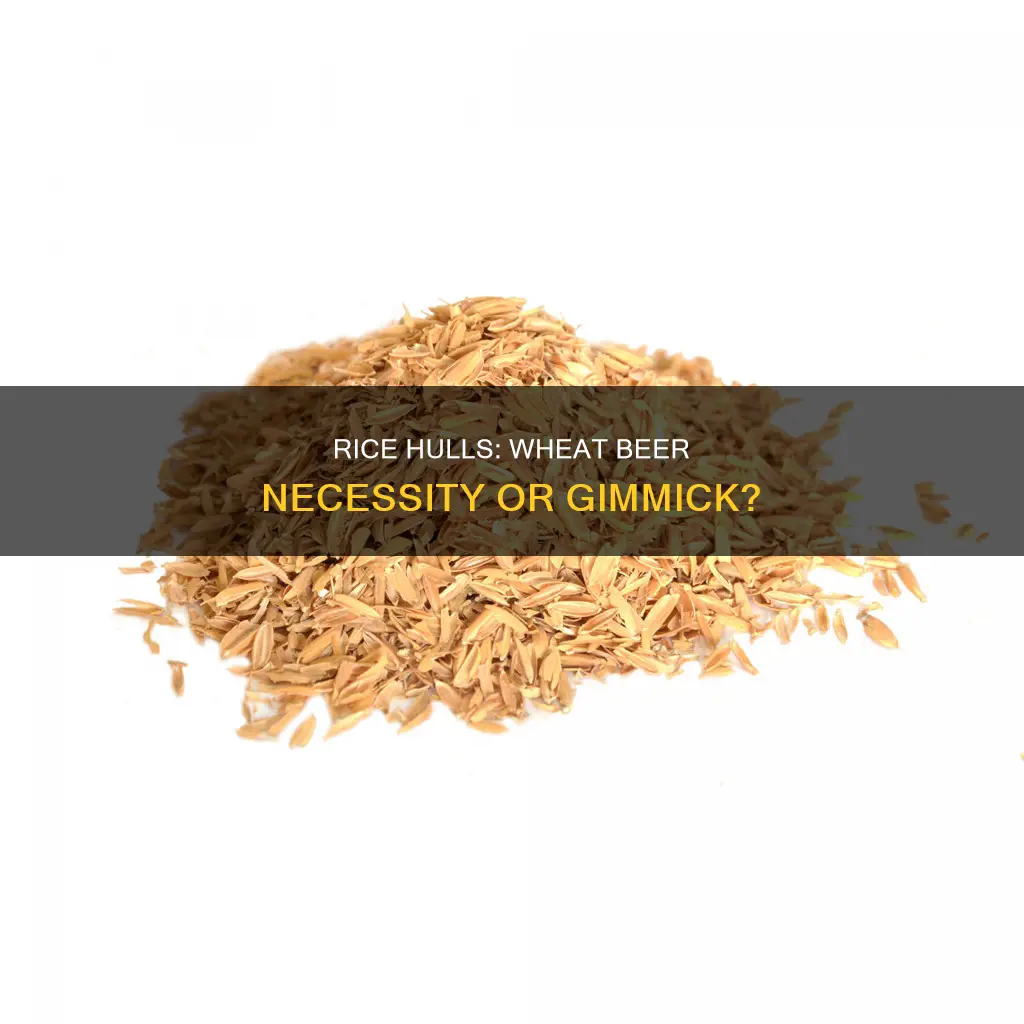
Rice hulls are the hard outer layers of rice grains. They are often used in brewing to improve wort flow through the mash (or lauter) bed. They are particularly useful when brewing wheat beers, as wheat grains have higher levels of protein and beta-glucan, which can increase wort viscosity and lead to a stuck mash. Adding rice hulls to the mash can help improve wort runoff rates and clarity without affecting the flavour or colour of the beer. While some brewers recommend using rice hulls in all beers, others suggest that they are only necessary when brewing with high percentages of wheat or other grains that can cause a stuck mash, such as rye or oats. The typical dosage is 1/2 lb for a 5-gallon batch, but the amount can vary depending on the percentage of wheat or other adjunct grains in the recipe.
| Characteristics | Values |
|---|---|
| Purpose | Prevent stuck mash, improve wort runoff rates and clarity |
| Usage | Mix into the mash, not the false bottom |
| Amount | Between 1% and 5% of the total grain bill, typically 1/2 lb for a 5-gallon batch |
| Preparation | Rinse before use |
| Applicability | Beers with high percentages of non-barley grains such as wheat, rye, or oats |
What You'll Learn

How much rice hull to use in a wheat beer
Rice hulls are the hard outer layers of rice grains. They are often used in brewing to ensure good wort flow through the mash or lauter bed. They are particularly useful when brewing wheat beer, as wheat has higher levels of protein and beta-glucan compared to barley, and lacks the husks that create needed porosity in a mash bed. Rice hulls help to "open up" the mash bed, improving wort runoff rates and clarity.
The amount of rice hulls to use in a wheat beer depends on various factors, such as the percentage of wheat or other adjunct grains in your recipe, the size of your batch, and the specifics of your brewing equipment. A good starting point is to add between 1% and 5% of the total grist weight in rice hulls directly to the mash. For a 5-gallon batch, this would typically be around half a pound of rice hulls, but some brewers use up to a full pound. If you are using a significant amount of wheat (over 30%), you may need closer to a pound of rice hulls.
It is important to mix the rice hulls in with the mash, rather than adding them to the bottom of the mash tun, as this can cause clogging. Rinsing or soaking the rice hulls before use is also recommended to remove any dust or debris.
Wheat Beers: Hoppy or Not?
You may want to see also

When to add rice hulls to the brewing process
Rice hulls are added to the mash before the hot water infusion, along with the dry grains. As the dry grains and rice hulls are mixed together, the rice hulls will help to create channels within the mash bed, which will improve the flow of water through the grains during the infusion process. This will help to prevent clumping and ensure that the water is distributed evenly throughout the mash, allowing for proper conversion of the grain starches into fermentable sugars.
Adding the rice hulls before the infusion also ensures that they are evenly distributed throughout the mash, which will improve filtration efficiency during lautering. This is because the rice hulls will create a filter bed at the bottom of the mash tun, which will help to prevent the grains from compacting together and creating a stuck mash.
Rice hulls are especially useful when brewing a high-gravity beer with a big grist. High-gravity beers require a larger amount of grains to produce the desired gravity, which can lead to a thicker mash that is more difficult to filter. Specialty malts, wheat, and rye are commonly used in high-gravity beers, and these grains have higher levels of protein and beta-glucan than barley grains. Beta-glucans are long-chain polysaccharides that contribute to the viscosity of the wort, which can make it difficult to filter.
It is recommended to use rice hulls at a percentage no greater than 5% of the total grain bill. A common measure is 1/2 lb per 5 gallons, with some brewers recommending a range of 1/4 lb to 1 lb per 5 gallons.
Dark Beers and Wheat: What's the Connection?
You may want to see also

The purpose of rice hulls in wheat beer
Rice hulls are the hard outer layers of rice grains. They are often used in brewing to ensure good wort flow through the mash or lauter bed. They are particularly useful when brewing wheat beers, as wheat grains have higher levels of protein and beta-glucan compared to barley, and lack the husks needed to create porosity in a mash bed. This can lead to a stuck mash, which rice hulls help to prevent.
When brewing a wheat beer, it is recommended to add rice hulls directly to the mash, mixing them in well rather than putting them on top. The typical dosage is around 1/2 lb for a 5-gallon batch, or between 1% and 5% of the total grist weight. It is also important to rinse the rice hulls before use to remove any dust.
Rice hulls are favoured by brewers as they do not contribute any flavour or colour to the beer and they do not break down in the mash, remaining stiff and helping to "open up" the mash bed. They can also help to improve the speed of the lauter, which is the process of separating the clear wort from the grain bed.
While rice hulls are commonly used in wheat beers, some brewers may choose not to use them if their wheat malt already provides sufficient rice hulls. Additionally, if using malted wheat, rice hulls may not be necessary as malted wheat has its own hulls.
German Wheat Beers: Sweet or Not?
You may want to see also

Rice hull alternatives in wheat beer
Rice hulls are often used in wheat beer to aid filtration and pressing operations. They are the hard outer layers of rice grains that are harvested as a by-product. However, they are not the only option for this purpose.
Wheat bran is a cheap alternative to rice hulls that works well. One source recommends malt conditioning as an alternative to rice hulls. Another suggests wrapping scrubbies or Scotch-Brite pads around the manifold to act as an added filter.
Oat hulls are another option for increasing bed porosity or reducing wort viscosity.
Belgian Beers: Wheat-Based Brews or Not?
You may want to see also

The impact of rice hulls on wheat beer taste
Rice hulls are the hard outer layers of rice grains. They are often used in brewing to improve wort flow through the mash bed, especially when brewing with high percentages of non-barley grains such as wheat or rye. These grains have higher levels of protein and beta-glucan, which increase wort viscosity and can lead to a stuck mash.
Rice hulls are added to the mash to improve filtration and prevent a stuck mash, but they do not contribute any flavour or colour to the finished beer. They are favoured by brewers because they remain stiff and act to "open up" the mash bed, improving wort runoff rates and clarity. The typical dosage is 1/2 lb for a 5-gallon batch, with a recommended maximum of 5% of the total grain bill by weight.
When brewing wheat beer, some brewers choose to use rice hulls to improve the speed of lautering and prevent a stuck mash, especially when using a high percentage of wheat or other sticky grains such as flaked oats and barley. However, others suggest that rice hulls are not necessary when using malted wheat.
In conclusion, while rice hulls may not have a direct impact on the taste of wheat beer, they can help improve the brewing process by preventing a stuck mash and improving wort flow. This can indirectly affect the final product by ensuring a more efficient and consistent brewing process.
Wheat Beers: Heavy, Bitter, or Both?
You may want to see also
Frequently asked questions
Rice hulls are not necessary but are often used in wheat beers to aid filtration and improve wort flow. They are added directly to the mash and help to "open up" the mash bed.
The amount of rice hulls used depends on the volume of the batch and the percentage of wheat or other grains. A good rule of thumb is to use between 1% and 5% of the total grist weight, with a minimum of 10-15% to prevent a stuck mash. For a 5-gallon batch, a typical dosage is half a pound.
Rice hulls should be added to the mash and mixed in well with the other grains. They should not be put through the mill or placed directly on the false bottom of the mash tun as this can clog things up.







